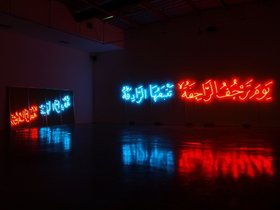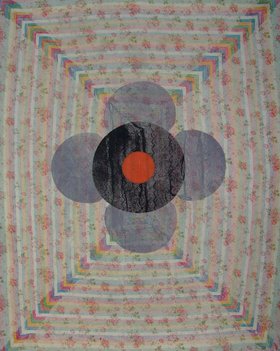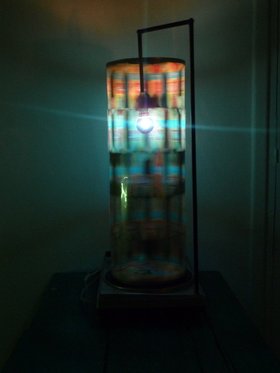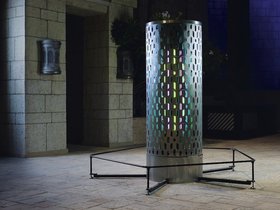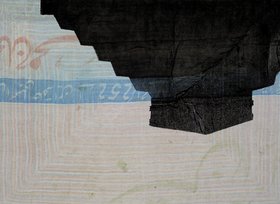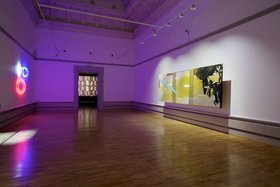Interviews
Un-thinking Systems
Shezad Dawood in conversation with Sara Raza
Engaging with a wide range of media, and executed across numerous networks and locations, Shezad Dawood’s work questions set parameters, both practical and conceptual. Pop culture, Sufism and structural filmmaking are just some of the elements that are regularly cited in his far-reaching practice. Dawood also explores ideas about mutability and hybridity, and here discusses work that will feature in his show at Modern Art Oxford, which runs from 4 April to 10 June 2012. The show includes New Dream Machine Project (2011), a film work and installation that examines Beat artist Brion Gysin’s stroboscopic flicker device and continues a series of investigations for which Dawood won the Abraaj Capital Art Prize in 2011.
Sara Raza: You have been working quite a lot in the MENA region and although Ibraaz’s focus is on the MENA, we’re trying to look at different dislocations and disconnects within the MENASA region but also beyond, interviewing various artists who are based in the diaspora but also several of those who are contesting these ideas about territory, geography, cartography and set ideas about visual cultural practice within those parameters. So, I’d like to start by discussing your practice, which is heavily multi-faceted; you layer many ideas, you explore many different mediums and you play with various genres in art history. Not an art history related to a particular region but often across different spaces and borders that are perhaps yet to be discovered. Could you talk about some of the challenges of criticality within your practice, working across such different platforms, both theoretical and practical?
Shezad Dawood: Well, I think I maybe ought to start by saying something of a manifesto. It’s interesting to see how the quote unquote global art world has reconstituted itself over the previous decade. Prior to that, there was a lot more interest, both theoretically and practically, in areas of hybridity and métissage, and what you have seen is almost a resurgence of nationalism in the last ten years, with very reified, new, art scenes, emerging strangely in parallel with new economies. So I think there are several questions that aren’t being asked, and there has been a certain triumphalism of the ‘other’ vis-à-vis the Euro-American art sphere. But what I put forward is that it’s actually the same action of power, it’s the setting up of the same binary, it’s coming from the same logic, the same iteration, therefore it’s actually not interesting at all – it’s the system reconstituting itself and reconstituting the border, reconstituting the frame and therefore a certain kind of compartmentalized reading of the world continues to be advanced. So I’d say that’s the problem we’re all facing and I think it’s very important for artists, writers and curators to be thinking beyond that. And yet it’s also a wonderful and damning illustration of human nature that most are not.
SR: Thank you. It’s interesting that you mention a manifesto because it’s something I am very much interested in, artists who are proclaiming about the art world in such a way that a critic or an art historian wouldn’t necessarily be able to, particularly when thinking about these new histories, where there is very little critical writing available at this stage, and it’s all very new. So it’s quite interesting that as an artist you would take that stance and say, these are the terms of the manifesto. It’s very refreshing.
SD: I think the present moment needs a far more radical incursion of thought and of systems, given the current state of economies, governments and so on. If we’re still playing about in the sand-pit of various easy binaries, it’s slightly onanistic – that’s me trying to be polite on camera. Twenty years ago there was already enough talk about a third space and obviously, it has certain problematics – some of the ideas around Homi Bhabha being of their time – but I think maybe without necessarily re-appropriating that syntax, but re-appropriating that line of enquiry and actually pushing it a bit further, starts to become very important. What’s important for me is a simple matter of getting out of the binary, that there are three points of intersection or contradiction before I’ll actually make anything. Otherwise, I don’t really feel like I’m doing my job. Maybe there’s a manifesto in that as well.
SR: There’s always that element of chance and fate, exploring the unknown. I know that you are very interested for example in magic and Sufism and there’s almost the element of delving into the unknown, or playing with the idea of sleight of hand.
SD: In my conversations I’ve noticed recently that to talk about magical Sufism, except in conceptually minimal terms, is really a bit of a no-no in the Euro-American sphere. Whereas to not talk about it when I’m with curators, writers, and artist friends in, say, Morocco – they think you’re mad. And I love that gap. That for me becomes the space in which I like to play and operate as an artist. That’s what you play for. One of my favourite research subjects that neatly inverts this notion is that in the seventeenth century in North Africa, in what is now Morocco, you had one of the first proto-type democracies, which was the Independent Pirate Republic of Rabat Salé. And it’s very interesting, because it was run by a council of freely elected pirates, usually based on how good a pirate they were.
SR: Weren’t they Kazakh?
SD: People came across from everywhere. It became a kind of Mecca (I’ll just throw that in there for fun) for mavericks. And what interests me about it is how could one create that space today, even virtually, perhaps? I was just in Morocco doing a project at L'appartement 22 and was talking to a number of artist friends and we actually wrote a manifesto for a republic of pirates based on a shared interest in the Independent Pirate Republic of Rabat Salé. It lasted for about 50, 60, maybe even 70 years and what was interesting is that in the seventeenth century, Christianity was the repressive religion and so a lot of Europeans, particularly French and Dutch for some reason, would convert to Islam, go renegade and become pirates. Ethnicity, in fact, was no barrier to advancement. There was a Dutch captain who sat on the council, obviously he was no longer Johannes Krebbe or whatever, he was now Bin Abdullah Ali Bin Suleiman, or something. But I liked that free movement of exchange, for me that’s almost pivotal to the current breakdown we’re experiencing. Until you have the free movement of people, nobody can speak of democracy.
SR: There’s also that ‘going native’ track; one has to avoid it.
SD: I think, instead of going native, one has to go maverick, where the subjectivity just becomes mutable. In a way, one might say that it’s dishonest but I think that to live in the current conditions is dishonest and actually to start to take them to task and to play with them, is crucial. I think that act of play, of free play – and to go back to that idea of working across different contexts and media – starts to enact something political, to enact it rather than to reify it as a temporary subject of the work.
SR: The project that you mentioned at L'appartement 22 is not your first engagement with North Africa. I’m well aware – we all are – that you were awarded the Abraaj Capital Art Prize for 2011. I wanted to speak to you a little bit about this kinetic engagement that you explored, particularly the kinetic sculpture that you created for this project, but also this wider idea of maverick engagement with various disparities, people who are travelling and also ideas about travel and music, of an ‘ideal’ festival that you brought forth with this project. Could you please share?
SD: Yes – let me try and condense it into some sort of intelligible response. The whole project for which I won the Abraaj Capital Art Prize was something I had been developing for many years. And it was the kind you have as an artist that’s one of a number of dream projects that sits on the shelf and every so often you take it off, dust it and try again to see if anybody will help you realize it. Obviously I have an interest in Beat culture, Brion Gysin and William Burroughs but I was particularly fascinated with this link to Tangiers at a particular moment, which is largely ignored in the history of Beat culture. It’s interesting that the whole Beat generation fled the more repressive regime in the States to go to Tangiers, not far from Rabat Salé, interestingly enough. But you had a very repressive regime in Morocco at the time, which gets largely ignored. But also what gets ignored – and I’ve been a fan of Gysin since I was a teenager, you mentioned something earlier about folding methods and I’m very into that idea of cut-ups, which even feeds into my films – is the point at which Gysin was interested and impassioned and deeply influenced by Sufism. You can see it in his early drawings, before the Dream Machine came about, and in some of his paintings; the patterning of the Dream Machine is Islamic. And yet even now, with Gysin plucked from the dustbin of art history, with shows at the New Museum and the Musée d’Art moderne de la Ville de Paris, you’ve still got this kind of marginalia of his time in Morocco, which is obviously pivotal. And again you’ve got this métissage, but it’s not just about Gysin. When he was in Tangiers, his lover was Mohamed Hamri, the painter and writer and together they owned what would now be seen as a slightly dubiously named ‘1001 Nights' café in Tangiers,’ where the Master Musicians of Jajouka was the house band. And it was Gysin and Hamri who introduced Brian Jones of the Rolling Stones to the musicians of Jajouka, whose history is almost pre-Islamic and relates to almost pagan cultures around Pan and returning in the spring. And Brian Jones went and jammed with them and later recorded them for the cult album Brian Jones Presents the Pipes of Pan at Jajouka. So there are all of these networks that seem to interestingly parallel my evolving networks in Morocco.
I think what also interests me about the Dream Machine is the relationship to the early zoetrope and early proto-cinema, that idea of just light and movement, which is a fairly nuts-and-bolts cinematic architecture.
SR: Do you think that film is becoming the preferred choice for you as a medium – is it one of the strongest mediums you can articulate your ideas through? Are you finding more of a move towards film?
SD: I think there’s a move towards film, but just because there’s more possibility in terms of finding the support for the projects I’m doing. But equally, particularly with the textile paintings, it’s really over the course of the last three to four years that they’ve grown up and that’s happened in parallel with the films.
SR: So there’s a duality going on?
SD: There’s a real sense of layering and montage playing off against each other.
SR: Do you feature your textiles within your films?
SD: I have done in the recent science fiction film [Piercing Brightness, 2011], just minimally. A lot of my ideas around science fiction were being worked out in a very abstract, formalistic way in some of the earlier textile pieces and those helped me to get a handle on or maybe to approach, the narrative around the film. And then, certain uses of device in terms of colour, lighting, even certain filters – for instance, I re-furbished an old 1970s prism filter for use on the science fiction film and something in the way that it refracts the image very definitely fed back into the textiles when I came back into the studio once we had finished shooting. So, there’s a very direct, almost visceral interplay, between the films and the painting. And I’m really enjoying that space because they both, as I say, have this layered aspect. I’m enjoying the shift into a greater degree of abstraction in neon as well because that idea of light and colour starts to have more of a reason to be in relation to the film.
SR: It’s a very exciting time in your career and particularly for your audiences as well and for the people who have been working closely with you over the years. So, for the solo show at Modern Art Oxford, it is going to be in the form of a retrospective, a mid-career retrospective?
SD: No, I think it’s more of a mid-career slice, like a slice in time, which seems to fit more, conceptually, with the whole way in which I work. So, it’s nice to finish where we started – it’s a manifesto of practice over the last three years and that syncretic interplay between the textiles, neons and films is something I’ve really tried to work out. And even the way the works are installed says something about a kind of methodology that for me is a very particular, but very precise, way of looking at editing, montage and layering and this idea that you raised about certain different narratives and histories, even if they are often contradictory or contrapuntal, and starting to see it altogether to see new openings onto some of those corridors that we spoke about. I think that my work, if it does nothing else but détentes people through 90 degrees so they look at the world from a different vantage, has already done enough. And I hope that the upcoming show will go some way towards actually putting forward a bolder manifesto about what the practice is actually about. I owe a lot to the people who supported me thus far. And that’s part of that idea of collaboration, it’s not just the people I collaborate with in my films, it’s the people I have conversations with, it’s the people I talk to who give me feedback on the work and edits, who are countless, and I think it’s really important to see your practice as a much larger enterprise than just one person or one artist.
Shezad Dawood was born in London in 1974. He received an MPhil in Fine Art Photography from the Royal College of Art before gaining his PhD from Leeds Metropolitan University. He has held solo exhibitions at The Third Line, Dubai (2008); Galleria Riccardo Crespi (2008); Galerie Gabriel Rolt, Amsterdam (2009) and Aarhus Kunstbygning, Denmark (2010). His work also featured in The Empire Strikes Back: Indian Art Today at the Saatchi Gallery (2010); Making Worlds, the 53rd Venice Biennale and Altermodern at Tate Britain (both 2009).

